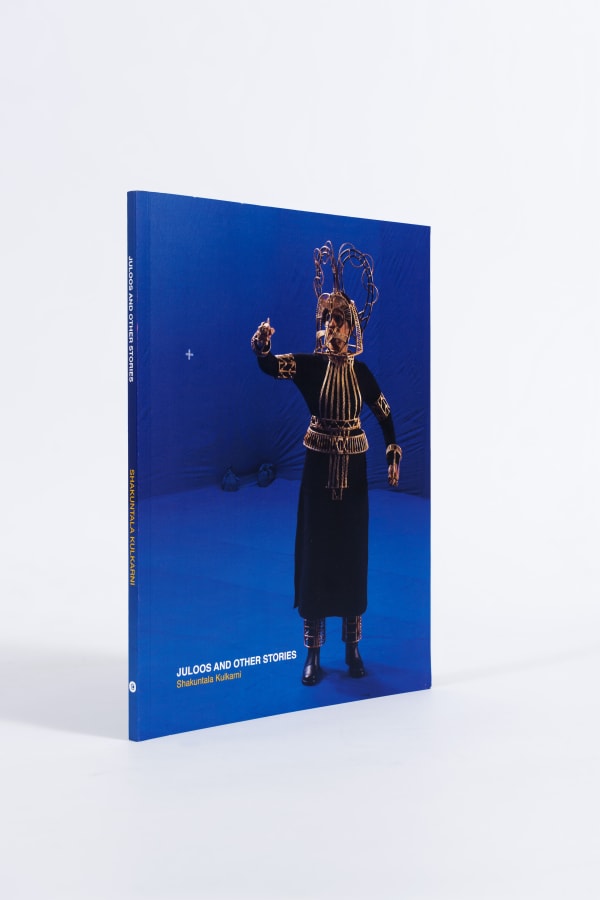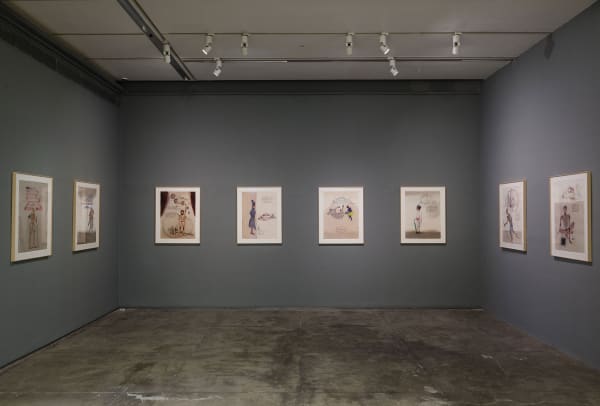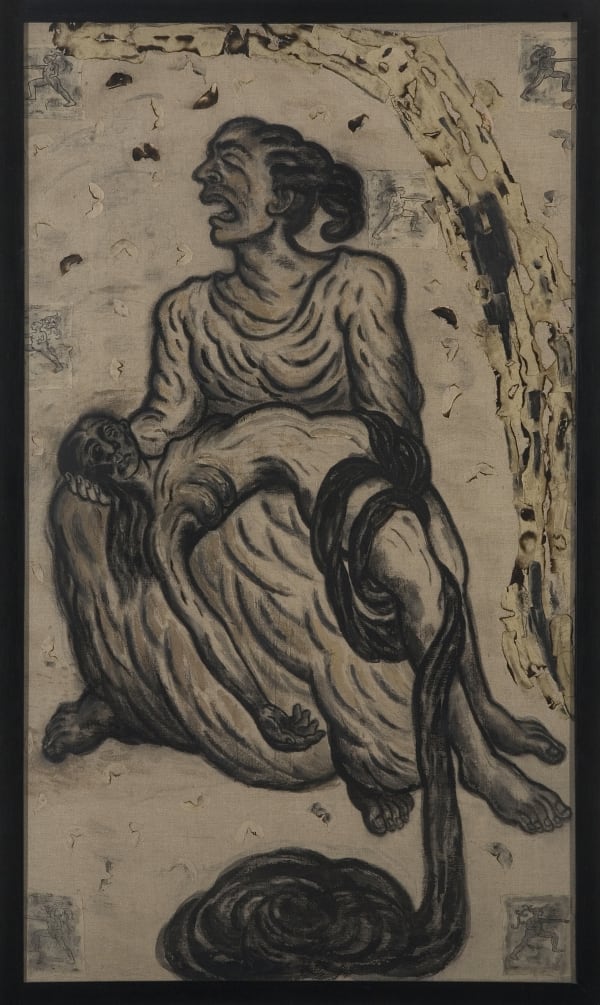Shakuntala Kulkarni Indian, b. 1950
b. 1950, in Karnataka, India
Shakuntala Kulkarni is a Bombay based, Karnataka born multidisciplinary artist who was trained at the Sir JJ School of Art, MSU Baroda, as well as Santiniketan under Somnath Hore. Originally trained in mural painting, Kulkarni’s work continued in the vein of addressing large audiences, but shifted from flat surfaces into sculpture, performance, and new media. Her work is primarily concerned with the plights of urban women who are held back by traditional patriarchal constraints, capturing the wounds and anxiety that come from those constraints in a vein similar to Hore.
In her 1994 work ‘Beyond Proscenium,’ which began the experimental and performative practice that she is now celebrated for, Kulkarni created a sculptural stage of wood and acrylic painted canvas. This work drew Kulkarni’s relationship with space off of two dimensions, and viewers, dancers, musicians, writers, and other performers activated Kulkarni’s sculptural space. Through creating such sites and spaces, Kulkarni creates a space for empowerment, especially for women. In 1996, Kulkarni created an installation called ‘Caryatid-a Viewpoint,’ reflecting on the idea of women as the supporters of religious structures, and women as the supporters of society.
In a multimedia installation titled ‘Reduced Spaces’ from 2001, Kulkarni addressed the claustrophobia, fear, and alienation that women in India often feel due to societal constraints, and invited viewers into a difficult to navigate bamboo and gunny sack structure where they could physically connect with the claustrophobia experienced by the female protagonist displayed in five video works. Live performance also played into this work, and a dancer explored tai chi based movements to demonstrate the explosive female energy that can pervade restricted space.
Kulkarni is able to represent tension not only through space, but also through time, addressing generation gaps. In ‘Ajjincya Goshti (Grandmother’s Tales),’ a three channel video work from 2004, viewers experienced takes on middle-class societal norms from guardians of tradition, elderly women between the ages of 78 and 86. Responding to questions about social order such as “who has the right to speak and for whom and about what?” viewers are able to see the tension between ageing Indian values in the face of India’s fast-paced modernization.
In her 2007 solo exhibition at Chemould Prescott Road, ‘and when she roared the universe quaked', the artist interspersed interactive installations and video works with large-scale, two-dimensional paintings on fabric, where she explores the paradoxes of the female body in psychologically layered works such as ‘Unsung Epics V.’ In the title work of the exhibition, the artist placed 152 paintings made from acrylic, glass, and fabric on the ceiling, inviting viewers to become a part of the installation by viewing the paintings through reflections in hand-held mirrors. In line with her works from the '90s, the viewer becomes a part of the artwork.
Furthering this idea, Kulkarni exhibited a celebrated body of work, ‘Of Bodies, Armor, and Cages,’ in 2012 at Chemould Prescott Road, the Kiran Nadar Museum of Art, the MMKA in the Netherlands, and Art Unlimited at Art Basel. Kulkarni explored the idea of women in public spaces, and created sculptural armors out of cane that not only protected the female protagonist, but also elevated her to a goddess-like stature. However, there is a tension between the notion of being protected and the notion of being trapped. In a series of performances documented in photographs, the protagonist stands in different historically important locations in Bombay that are in danger of being destroyed, using her armor and will to protect her city from cultural invasion.
The artist lives and works in Mumbai, India.
-

In the making: Drawing, Refining, Revising
Group Show 2 Aug - 3 Sep 2024In the Making: Drawing, Refining, Revising is a group exhibition where we have brought together 15 artists from the gallery to whom drawing is the essence of studio life: a...Read more -

Part 1: Framing | CheMoulding: Framing Future Archives
Curated by Shaleen Wadhwana | 60 Years of Gallery Chemould 15 Sep - 22 Oct 2023Anant Joshi, Archana Hande, Atul Dodiya, Bhuvanesh Gowda, Desmond Lazaro, Dhruvi Acharya, Gigi Scaria, Jitish Kallat, Madhvi Subrahmanian, Meera Devidayal, Mithu Sen, NS Harsha, Ram Rahman, Ritesh Meshram, Shakuntala Kulkarni,...Read more -

Quieter Than Silence - compilation of Short Stories
Shakuntala Kulkarni 9 Mar - 6 May 2023DRAWING OUT, DRAWING IN Human bodies take on peculiar forms in Shakuntala Kulkarni's drawings. Costumes and armour become fused with the body giving them bizarre appearances, and when unclothed, the...Read more -

Modus Operandi III: Together Alone
Group Show 11 Aug - 10 Sep 2022The premise of Modus Operandi began and continues with an exhibition of Chemould's roster of artists - every iteration presents us an opportunity to exhibit them under one roof, in...Read more -

Photo / Concept
Group show | In-Touch Edition II 5 Jun - 5 Jul 2020Read more -

Modus Operandi II
Group Show 18 Jul - 24 Aug 2019Synonymous with the first edition of Modus Operandi, where we brought together over 25 Chemould artists and their unique artistic language in dialogue with each other through various mediums, we...Read more -

Modus Operandi
Group Show 13 Jul - 18 Aug 2018This July, Chemould Prescott Road presents Modus Operandi , a show that has been devised by Shireen Gandhy and the Chemould team, brin ging together a large number of Chemould...Read more -

Juloos and Other Stories
Shakuntala Kulkarni 14 Mar - 7 Apr 2018The film Juloos is a declaration of the vision that each and every person has equal rights and freedom as an individual, and, as part of a community. Within the...Read more -

A Summer Mix
Group Show 20 May - 15 Jul 2015Aditi Singh | Anju Dodiya | Atul Dodiya | Bhuvanesh Gowda | Desmond Lazaro | Dhruvi Acharya | Gigi Scaria | Jitish Kallat | Lavanya Mani | Meera Devidayal |...Read more -

Aesthetic Bind: Cabinet Closet Wunderkammer
50 Years of Chemould | Group Show 20 Jan - 3 Mar 2014There are small exhibitions within this exhibition compacted by a set of framing devices. The Closet holds intimate things: clothes, mementos, secrets about self and identity, fears or even crimes....Read more -

Of Bodies, Armour and Cages
Shakuntala Kulkarni 17 Aug - 15 Sep 2012Kulkarni has been fascinated by the very structure, and the grandeur of the armour: masculine, stiff, strong, lasting and peerless in nature. Armors in the days gone by, were worn...Read more -

And When She Roared The Universe Quaked
Shakuntala Kulkarni 12 - 30 Oct 2007In 'And When She Roared The Universe Quaked” Shakuntala Kulkarni examines gendered, female, creative/creating bodies as a site of both “otherness” and empowerment. By adopting a vocabulary of defamiliarised bodies,...Read more -

crossing generations: diVERGE
40 Years of Chemould | Group Show 2 - 14 Dec 2003diVERGE is premised on the polyphony articulated by contemporary artists in India. Rather than zooming in to chart a convergent discourse, the exhibition pans over a diverse spectrum of subjectivities...Read more
-

Aesthetic Bind
50 Years of Contemporary Art 2013 - 14SoftcoverRead more
Dimensions: 24 x 29 cm -

And When She Roared The Universe Quaked
Shakuntala Kulkarni 2007 Read more -

crossing generations: diVERGE
40 Years of Gallery Chemould 2003SoftcoverRead more
Dimensions: 29.5 x 23 cm -

Juloos and Other Stories
Shakuntala Kulkarni 2019SoftcoverRead more
ISBN: 978-81-943497-1-6
Dimensions: 28 x 22 cm -

Of Body, Armour and Cages
Shakuntala Kulkarni 2012 Read more
-

Art Mumbai
Mumbai 16 - 19 Nov 2023Read more -

Art Basel 2023
Basel, Switzerland 15 Jun - 18 Dec 2023Booth J9 We look forward to welcoming you once again in person to our booth at Art Basel 2023. Highlights will include works by Anju...Read more -

Art Basel 2018
Basel, Switzerland 13 - 17 Jun 2018Chemould Prescott Road presents a suite of works this year at Art Basel that reflect the diverse sensibilities of its gallery programme. From Anju Dodiya...Read more -

Art Basel 2013 Unlimited
Basel, Switzerland 13 - 16 Jun 2013Public days: June 13 - 16, 2013 Chemould Prescott Road has a roster of senior, mid-career and young artists who have been part of the...Read more

















